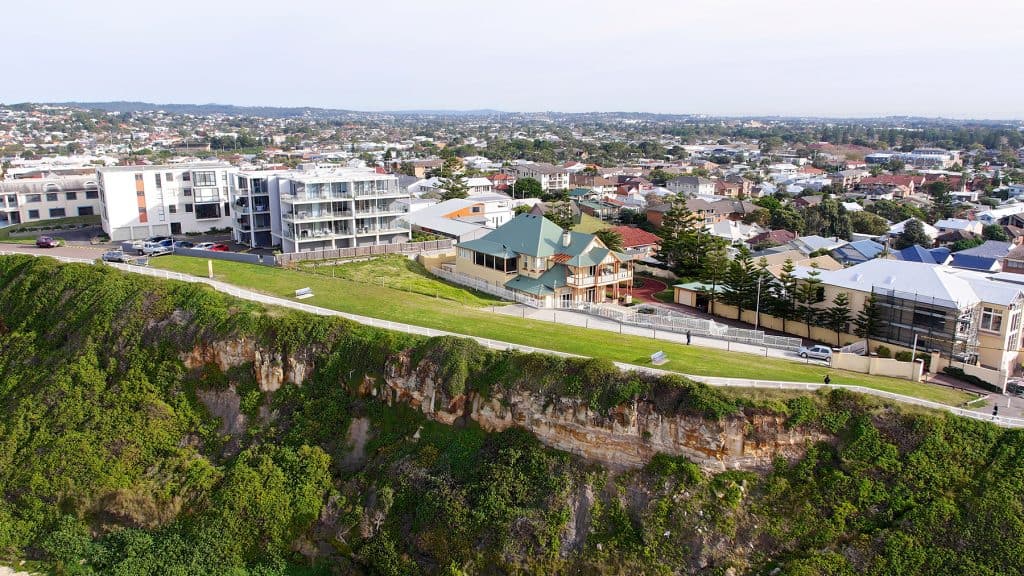One of the largest industries for drones in Australia is in real estate photography. Drones have the ability to catch a unique angle of property in a cost-effective way and can ultimately add value to the final sale price of a property.
If you’re looking to get into drone photography and cinematography for real estate here are our key tips on how to ensure you get the best results and set up your business for success.
The good the bad and the ugly
As the UAV market has expanded the number of operators using drones for real estate photography has expanded which has led to both good and bad outcomes for the industry.
On one hand, the availability of photo and videos for real estate has increased, and the cost of achieving them has dropped significantly in recent years. We have seen excellent examples of drone real estate photography and cinematography.
However we’ve also seen a significant increase in the number of untrained, uninsured and illegal operators who more often than not produce low-quality results failing to add value to the property being sold.
UAV training
It should go without saying that without quality training you really don’t know the risks and best practices associated with UAV operations. By being trained by professionals who have operated in the industry for years you learn to avoid problems before they occur and how to achieve almost any shot without putting yourself or anyone else at risk.
Public liability insurance
Real estate agents will expect that you have public liability insurance to operate your business. Currently the only way to get public liability insurance for UAV operations is to be fully trained and have an operator’s certificate for your company.
It’s worth noting that the cost of doing this has decreased significantly in recent months and if you are interested in starting a business in this industry we are happy to discuss your idea and head you in the right direction.
It’s not all about the drone
Many operators starting out in the UAV industry miss a very important point about drone operations, particularly when conducting real estate jobs.
We get to see videos that our graduates produce and one of the clearest markers of a professional operator is their ability to seamlessly edit footage or images captured from a drone with other footage collected from within the house or at ground level. Take a look at this stunning drone real estate video from one of our graduates.
For those operating a real estate cinematography business this is a stunning example of how to go about creating value for your client and ensuring that you will be invited back again. What’s been achieved in a video like this is value for money for your client.
Anyone looking to buy this property has learned more about the building and its surrounds, in fact it has potentially increased the interest in the property and even the price. Our graduate hasn’t just thought about places that he can fly a drone but thought about the video that needed to be created and has simply used the drone as a tool to help achieve the process.
What makes the difference between an average operator and excellent operator is the ability to think about the data that you’re capturing, in this case creating a fantastic video that people want to see. It’s also worth noting that editing and music have been put together in a clean simple way and the audience don’t really think about the drone in the production of this video.
The drone
The Phantom 4 is easily the best value for money drone on the market today, it’s ability to work smoothly to capture high quality imagery in the right conditions and it’s easy flying make it the ultimate entry level drone by far.
However, when you’re working for a living, the ability to take shots in low light or less than ideal weather conditions becomes crucial to being able to achieve a good product. In the above video our graduate used inspire 1 X5 with a 4K camera which set him back about $5,000. He’s invested in a machine that is capable of producing high quality results in a range light and weather conditions.
At UAVAIR we’ve made a sport out of picking which drone was used to achieve certain shots and we can see the difference between a Phantom 3, Phantom 4 and an Inspire 1. The smoothness of a shot, the depth of colour and light and how the UAV travels through the air can all be determined by someone that knows what to look for. It’s also important that the client sees you running high quality equipment.
(Nick Smith started his career in Real estate photography and manages a fleet of 10 heavy lift UAV’s)
When you pull a $25,000 drone out of its case you help set the tone for your professionalism. Now this isn’t in and of itself a reason to buy a $25,000 piece of gear but it is a factor to consider. We aren’t saying that a phantom 4 can’t do the job, as we said before they are an incredible machine and many people use them for professional work but the reality is, the cost of a drone when you’re setting up a company isn’t the biggest part of that investment and investing in the highest quality that you can may make all the difference.
There are many more industries where you can deploy drones and we love to see our graduates moving into newly emerging fields like mapping, asset inspection, agriculture and scientific monitoring, but real estate drone photography and videography is a great way to get started in the industry. If you want to learn more about what’s required to launch your career in this rapidly expanding field then give us a call on 1300 893 340.
